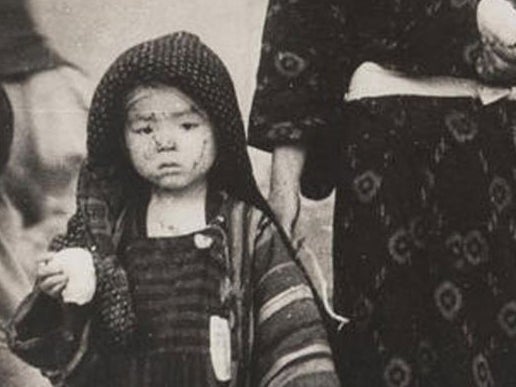Photos of Nagasaki reveal devastating aftermath of 1945 US atomic bomb
Moving images captured in the aftermath of the attack, showing the devastated city, its surviving inhabitants and US troops, are being auctioned this week

The destruction and suffering caused by nuclear weapons has been laid bare in a moving collection of photographs taken after America dropped an atomic bomb on Nagasaki in August 1945.
Last year, celebrations were held to mark the 70th anniversary of the detonation of the “fat man” bomb over the Japanese city, killing tens of thousands and leading to the end of the Second World War.
Now poignant images captured in the aftermath of the attack, showing the devastated city, its surviving inhabitants and US troops, are being auctioned this week.
The bombing of Nagasaki
Show all 5Among some 250 photographs in the album compiled by an American military policeman are 24 haunting shots of a city in ruins taken by Japanese military photographer Yosuke Yamahata.
Mr Yamahata’s pictures appeared in Japanese newspaper the Mainichi Shimbun two weeks after the atomic bomb was dropped.
But the originals were confiscated by the American military under strict censorship rules, according to RR Auction, which is selling the rare album.
They re-emerged fifty years later in 1995, when some of the negatives were restored to reveal never-seen before pictures of the bomb’s devastating effects.
The rare photographs are expected to sell for around $50,000 (£38,000) – just two years after they were last auctioned at Bonham's.
Upon hearing the news of the bombing, Mr Yamahata took a train to the city along with the writer Jun Higashi and the painter Eiji Yamada, arriving at 3am the following day.
Having been instructed to document the destruction for military propaganda purposes, he worked from dawn to dusk, taking around 119 photographs on two different cameras.
But, unbeknown to Mr Yamahata at the time, one of his cameras had a faulty shutter device - the images to be auctioned are thought to include 12 taken from the original negatives of this defective camera.
They show a city riven to the ground and dotted with dazed and blackened survivors.
Writing later about what he had experienced that day, Mr Yamahata described Nagasaki as “hell on earth”.
He said: “The appearance of the city differed from other bomb sites: here, the explosion and the fires had reduced the entire city (about four square kilometres) to ashes in a single instant.
“Relief squads, medical and fire-fighting teams, could do nothing but wait. Only the luck of being in a well-placed air raid shelter could be of any use for survival.”
He went on: “Even if the medical and fire-fighting teams from the surrounding areas had been able to rush to the scene, the roads were completely blocked with rubble and charred timber. One had not the faintest idea where the water main might be located, so it would have been impossible to fight the fires.
“Telephone and telegraph services were suspended; the teams could not contact the outside world for help. It was truly a hell on earth. Those who had just barely survived the intense radiation-their eyes burned and their exposed skin scalded-wandered around aimlessly with only sticks to lean on, waiting for relief.
“Not a single cloud blocked the direct rays of the August sunlight, which shone down mercilessly on Nagasaki, on that second day after the blast.”
Subscribe to Independent Premium to bookmark this article
Want to bookmark your favourite articles and stories to read or reference later? Start your Independent Premium subscription today.

Join our commenting forum
Join thought-provoking conversations, follow other Independent readers and see their replies